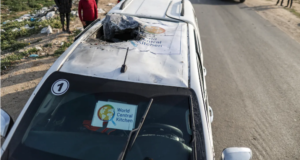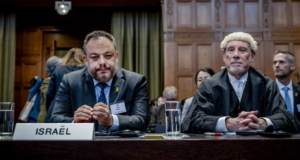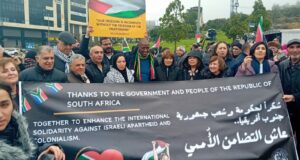Israel/Occupied Palestinian Territories (OPT)
Read the entire report covering every area of the globe at http://hrw.org/wr2k6/
Following the death of Palestinian leader Yasser Arafat in November 2004, Palestinians held their second-ever national elections on January 9, 2005. The main contender, Mahmoud Abbas (Abu Mazen), became the second Palestinian president with 62.52% of the vote. The Palestinian Authority (P.A.) postponed Legislative Council elections, which were due to take place in 2005, until January 2006, but held first-ever municipal elections in four stages across the West Bank and Gaza, with Hamas gaining a substantial leadership role in local politics, especially in Gaza. The P.A. has postponed a fifth and final round of voting, which includes fifty-nine local councils, until 2006.
On February 8, 2005 Mahmoud Abbas and Israeli Prime Minister Ariel Sharon met in Sharm el-Sheikh for the first Israeli-Palestinian summit in four years. The summit ended in a loose ceasefire agreement “that all Palestinians will stop all acts of violence against all Israelis and at the same time Israel will cease its military activity against all Palestinians everywhere.” While Islamic Jihad and Hamas said they were not bound by the ceasefire, they did commit to respecting a mutual period of calm.
As part of the ceasefire, Israel agreed to release nine hundred Palestinian prisoners, which it did in February and June. Approximately eight thousand Palestinian political and security prisoners remain imprisoned by Israel. Israel also currently holds more than six hundred Palestinians under administrative detention (detention without trial or charge, which can be indefinitely renewed).
In August and September 2005, Israel unilaterally withdrew approximately eight thousand settlers, along with military personnel and installations, from the Gaza Strip and four small settlements in the northern West Bank near Jenin. While Israel has since declared the Gaza Strip a “foreign territory” and the crossings between Gaza and Israel “international borders,” under international humanitarian law (IHL), Gaza remains occupied, and Israel retains its responsibilities for the welfare of Gaza residents. Israel maintains effective control over Gaza by regulating movement in and out of the Strip as well as the airspace, sea space, public utilities and population registry. In addition, Israel declared the right to re-enter Gaza militarily at any time in its “Disengagement Plan” Since the withdrawal, Israel has carried out aerial bombardments, including targeted killings, and has fired artillery into the northeastern corner of Gaza.
While the total number of Israeli and Palestinian casualties fell in 2005 following the February ceasefire, the overall human rights situation in Israel and the OPT remained grave. Since the beginning of the current intifada in September 2000, Israel has killed nearly three thousand Palestinians in the West Bank and Gaza, including more than six hundred children. During the same period, Palestinian fighters have killed more than nine hundred Israelis inside Israel and in the OPT. Most of those killed on both sides were civilians.
The Israeli authorities continue a policy of closure, imposing severe and frequently arbitrary restrictions on freedom of movement in the West Bank, Gaza Strip, and East Jerusalem, contributing to a serious humanitarian crisis marked by extreme poverty, unemployment, and food insecurity. The movement restrictions also have severely compromised Palestinian residents’ access to health care, education, and other services. As of August 1, 2005, the U.N. Office for the Coordination of Humanitarian Affairs (OCHA) reported 376 closure obstacles, down from 605 in February. However, this decrease, a result of the Sharm summit and the subsequent decrease in fighting, is offset by an increase in the number of “flying checkpoints” (currently an average of sixty each month), which usually consist of a military jeep blocking a road and checking all traffic for an undisclosed period of time; an increase in concrete military towers and “road protection barriers”, which block Palestinian traffic from entering settler-only roads through the OPT; and the increased movement restrictions associated with the “separation barrier” or “wall” that Israel is building mostly inside the West Bank.
During 2005, Israel continued with its construction of the wall, notwithstanding the International Court of Justice’s Advisory Opinion declaring the construction of the wall inside the OPT a violation of IHL, and demanding that Israel cease further construction inside the OPT. While the stated Israeli security rationale for the wall is to prevent Palestinian armed groups from carrying out attacks in Israel, 85 percent of its route extends into the West Bank, facilitating the eventual annexation to Israel of most of the large illegal Jewish settlements constructed over the past several decades as well as some of the most productive Palestinian farmlands and key water resources.
In July 2005, the Israeli Knesset approved legislation that effectively bars Palestinians from the OPT from suing Israel for death, injury or damages caused by Israeli security agents. The amendment to the Civil Wrongs (Liability of State) Law, 5712-1952 further strips Palestinians of an effective remedy for serious human rights abuses, which is required under international human rights law. The Knesset passed the bill at a time when the Israel Defense Forces (IDF) had criminally investigated fewer than ten percent of the Palestinian civilian deaths since September 2000, and have convicted only a handful of IDF soldiers for causing death or injury. In August, an Israeli court handed down an eight year sentence, by far the longest of the past five years, to the soldier found responsible for lethally shooting Briton Tom Hurndall in Gaza in 2002. The IDF maintains the policy that killings of Palestinians will be investigated only under “exceptional circumstances,” which neither the IDF nor the government has ever defined. The Israeli authorities’ failure to bring perpetrators to justice fosters a culture of impunity.
The Knesset also passed legislation in July 2005 barring family reunification between Israeli citizens (mostly Palestinians) and their Palestinian spouses from the OPT, except in certain age categories. Since 2002 Israel has frozen family reunification and forced thousands of married couples and their children to live apart or live together illegally. This law violates the right not to be subjected to arbitrary interference with one’s family as set out in international human rights treaties ratified by Israel.
In the OPT, despite Abbas’ pledges of restored law and order and his reorganization of the security services, including firing long-standing officials who P.A. authorities deemed inept or corrupt, control of the Palestinian Authority over Palestinian population centers is frequently nominal at best, and conditions of lawlessness have increased in the Gaza Strip and parts of the West Bank in 2005. Palestinian gunmen carried out several assassinations against persons alleged to have collaborated with Israeli security forces, and fighting between various Palestinian factions, security services and armed groups has led to armed clashes on the streets, vigilante killings and even the kidnapping of foreigners on several occasions in Gaza.
Since taking office, Abbas has overseen the execution of five death row inmates. At least twenty-two people remain on death row, many of them tried in the notorious Palestinian security or military courts where minimum standards of due process are not met. On June 22 Abbas ordered that the Palestinian justice system retry those whom the State Security Court had sentenced to death. It is unclear whether this process has begun.
Unlawful Use of Force
The Israeli army and security forces continued to carry out daily arrest raids and military operations in Palestinian areas during 2005. There have been over two thousand IDF incursions into Palestinian population centers this year. The IDF often carried out the operations in a manner that failed to demonstrate that it had used all feasible measures to avoid or minimize harm to civilians and their property. In one such incident, an August 24 arrest raid in the Tulkarem refugee camp, the IDF shot and killed five unarmed Palestinians, including three seventeen-year-olds. This incident reflects a growing pattern of IDF “arrest operations” in which security forces kill the target of arrest or bystanders rather than seeking to apprehend the target. More than 20 Palestinians were killed in assassinations or extra-judicial killings in 2005.
In 2005, the number of Palestinian suicide bombings and similar attacks targeting civilians inside Israel reached their lowest point since the beginning of the current intifada in 2000. Palestinian armed groups carried out three lethal suicide bombing attacks inside Israel in 2005, killing fifteen Israelis and injuring scores more. Armed groups also carried out several roadside shootings and bomb attacks in the OPT, killing several Israeli civilians. In addition, on several occasions, Palestinian armed groups in the Gaza Strip fired home-made rockets, known as Qassams, and mortar shells into Israel and at Jewish settlements in the Gaza Strip (up until the withdrawal in August), which killed several Israelis, Palestinians, and foreign workers. These weapons are inherently indiscriminate and are generally fired at civilian areas, in contravention of IHL. Abbas publicly denounced such tactics and called for an end to the armed uprising. Yet the Palestinian Authority appeared unable to stop those who have ordered or organized such attacks.
The Wall
On February 20, 2005 Israel modified the planned route of the wall. While the new route runs closer to the Green Line in some areas, such as the southern West Bank, in other areas it will run far inside the West Bank in order to capture key Israeli settlements such as Ariel (twenty-two kilometers inside the West Bank), the Gush Etzion bloc (with fifty thousand settlers) near Bethlehem and the Maaleh Adumim settlement east of Jerusalem. The new route is 670 km, twice the length of the “Green Line” (the 1949 armistice line between Israel and Jordan which served as the de facto border between Israel and the West Bank after Israel’s 1967 occupation); only about one-fifth of the route follows the Green Line itself. During 2005 Israel still failed to make the case why a wall constructed entirely on the Israeli side of the Green Line would not have been at least as effective in providing security inside Israel. Instead, the current wall will bring over three hundred thousand West Bank and East Jerusalem settlers and a minimum of 135,000 acres of West Bank territory over to the Israeli side. Despite Israel’s contention that the wall is a “temporary” security measure, it captures settlements that Israel has vowed to hold onto permanently. On July 21 Sharon said that the Ariel bloc of settlements “will be part of the State of Israel forever.”
The construction of the wall and settlement expansion essentially have cut off East Jerusalem from the rest of the West Bank. In June the Israeli cabinet approved the final details of the 60-kilometer fence around Jerusalem that will cut off some fifty-five thousand Palestinian Jerusalem residents from their city. Israel also has announced plans to build in the three thousand acre piece of West Bank land between Jerusalem and the West Bank settlement of Maaleh Adumim, known as E-1, and to surround the entire area with the wall. This will effectively sever the northern and southern West Bank.
Key International Actors
In April 2005, after meeting with Prime Minister Ariel Sharon, U.S. President George Bush “reiterated that the United States supports the establishment of a Palestinian state that is viable, contiguous, sovereign and independent.” Yet while the Bush administration expressed displeasure at Israel’s decision to build in the E-1 area of the OPT, and paid lip service to the call for a freeze in settlement expansion, it provided no political or economic sanctions on Israel’s continued building. Sharon publicly vowed to continue building despite U.S. displeasure.
Israel remained the largest recipient of U.S. military and economic aid, receiving almost U.S.$3 billion in 2005. In contrast, after a May meeting between Bush and Abbas, Bush pledged U.S.$50 million in aid to the P.A. for housing and other construction following the Israeli withdrawal from Gaza. However Congress later earmarked part of this money to be used to beef up “border crossings” along the wall, which are mostly located on occupied West Bank land. In September 2005, following the Israeli withdrawal, the United States approved disbursement of a U.S.$3 million supplemental grant to the P.A. security services.
Also in September, the Quartet (the United Nations, Russia, the European Union and the United States) foreign ministers met to welcome the successful conclusion of the Israeli withdrawal and call for renewed efforts to return to the Road Map (a performance-based plan with three phases which is supposed to build confidence in preparation for final status negotiations to end the conflict). Their final statement read: “The Quartet reaffirms that any agreement on final status issues must be reached through negotiations and that a new Palestinian State must be truly viable, with contiguity in the West Bank and connectivity to Gaza.” The Quartet also called for an end to settlement expansion and expressed concern regarding the route of the wall.
 International Solidarity Movement Nonviolence. Justice. Freedom.
International Solidarity Movement Nonviolence. Justice. Freedom.


